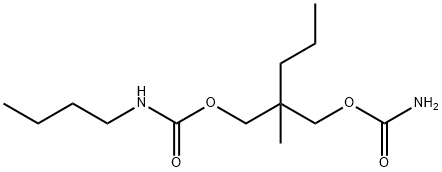Manufacturing Process
Diethylmethyl propylmalonate is reacted with LiAlH4, then H2SO4 to give 2-
methyl-2-propyl-1,3-propanediol. That is reacted with phosgene in toluene to
give the chlorocarbonate which is in turn reacted with butylamine to give N_x0002_butyl-2-methyl-2-propyl-3-hydroxy-propyl carbamate.
22.1 parts of N-butyl-2-methyl-2-propyl-3-hydroxy-propyl carbamate and 9.8
parts of urethane are dissolved in 300 parts of anhydrous xylene in a suitable
vessel equipped with an efficient distillation column. Xylene is distilled to
remove traces of water from the mixture. 2.3 parts of aluminum isopropylate
are added and distillation is continued until substantially the theoretical
quantity of ethanol has been distilled at about 78°C. The reaction mixture is
then freed from xylene by distillation under reduced pressure. Approximately
100 parts of water are added and the mixture again freed of solvent by
distillation under reduced pressure. 100 parts of trichloroethylene are added,
the solution filtered to remove insoluble matter and the solution freed of
solvent by evaporation. The residual oil is purified by molecular distillation at
a pressure of about 0.01 mm. 8.7 parts (35% of theoretical yield) of purified
N-butyl-2-methyl-2-propyl-1,3-propanediol dicarbamate are obtained.

